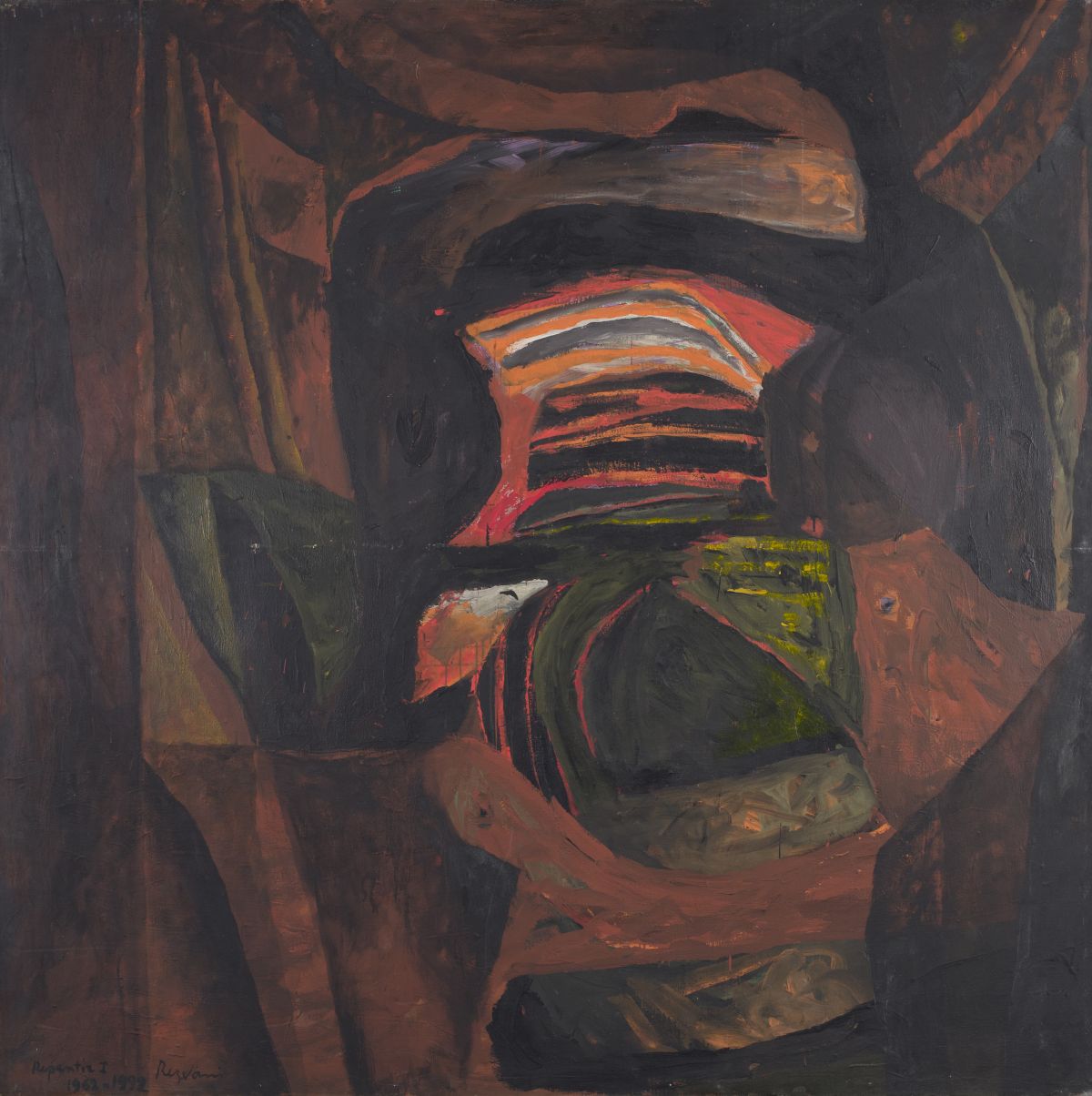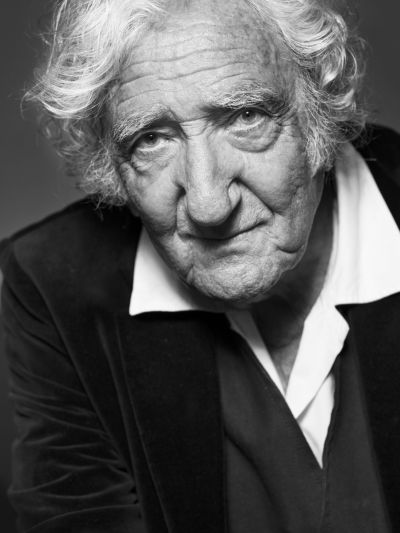
Serge Rezvani, Repentir I AA, Oil on canvas, 195 x 195 cm, 1962/1992 © Thierry Cohen
Serge Rezvani was born in Teheran on March 23, 1928, to a Persian father, a dancer and magician, and a Russian mother, a violinist and horsewoman.
Arriving in France at the age of one, his childhood was spent in the middle of nowhere, tossed about by the sufferings of a sick mother who led him to unbelievable Russian emigrant boarding houses, where only his precocious drawing skills enabled him to preserve himself, to exist by being admired a little.
Fleeing the terror of this prison world, at age 15 he hid under a false identity in German-occupied Paris, taking refuge in the workshops of the illustrious Académie de la Grande-Chaumière.
"I wanted to live painting, not produce paintings. I kept nothing that came out of my hands; drawings fell to the ground without my bothering to pick them up; for months I painted on the same canvas, which I scraped away when the layer became too thick. I loved the act of painting, I loved the life that the act of painting imposed, I loved the extraordinary tension that somehow took me out of myself when, standing in front of the canvas, I was no longer me but what was being done on the canvas."
At the age of 17, a chance meeting with Paul Eluard led to the production of Elle se fait élever un palais dans la forêt, a rare book, published in an edition of 16 copies, illustrated with Serge's engravings and a moving premonition of the wonderful love story he would have a few years later with Lula.
Serge and his friends, painters Jacques Lanzmann, Pierre Dmitrienko and sculptor Raymond Mason, believed in the power of the artist to change the world, and in painting as destiny.
The shimmer of his early works, humble compositions in rabbit-skin glue on burlap canvas, is perfectly at home in the informal art scene, too hastily dubbed the Second School of Paris. Critical and commercial success (exhibitions at Maeght (Les Mains éblouies), Arnaud, Berggrüen, Lucien Durand, Jacqueline Ranson in Paris and Hanover in London), painfully questioned Rezvani's relationship with painting.
Having adopted Picasso's dictum that it's not what the artist does that counts, it's what he is, he decided to flee Paris and the unbreathable climate of the art trade, to live with the absolute love of his life, Danièle-Lula, whom he had met in 1950.
It was in the Massif des Maures, a continent unique in the world, a place closed in on itself, that the couple settled in a small isolated house, La Béate. In this happy retreat, Rezvani assumes his desire for absolute distance, to be on the side, to deny the society of numbers in a simple and total quest for truth. Paradoxically, his painting expresses deep anguish, the traumatic overtones of a brutal experience. This duality between torment and joy illustrates the parallel lives of an artist who has always refused to cheat.
Then came the transition from brush to pen, isolation slowly imposing writing.
In the meantime, Serge, under the pseudonym Bassiak (va-nu-pieds in Russian), had passed on his tenderness and humor in a number of famous songs (Le Tourbillon (de la vie), Ma ligne de chance...) that delighted filmmakers François Truffaut and Jean-Luc Godard and their audiences, and today belong to a certain collective memory.
Les Années-Lumière (1967), Les Années Lulla (1968), Le Portrait ovale (1976) and Le Testament amoureux (1981) are passionate books that tell the story of their author's life, and are among the milestones of Serge's prolific literary and theatrical output, as he likes to call himself a multi-disciplinary artist. So, if painting is sometimes absent, it soon returns, for the author, nourished and enriched by the experience of writing, now knows that his hand can reveal what the brain doesn't know.
Thus, in 1971, Les horreurs de la guerre électronique (The horrors of electronic warfare), presented at the Toiles sur le Vietnam exhibition at the ARC, the contemporary department of the Musée d'art moderne in Paris. These were large-scale canvases against the war then being waged by the United States in Vietnam.
Then there's the formidable series of large canvases painted in 1974 and chosen to be shown in the still unfinished Centre Pompidou, a marvellous visionary declamation that can only be conceived as the paintings of someone who writes.
From then on, a subtle interplay governed the links between Serge's painting and his writing. Thus, in 1992, following Repentirs, paintings from the 1960s reworked thirty years later, echoes the 1993 publication by Stock [of] Repentirs du peintre. Multi-disciplinary!
This fertile duality, appeased and tamed, finds one of its ultimate and sublime echoes in Les Réserves, initiated in the late 1990s, shortly before Lula's death in 2004.
"I write as I paint, and I paint as I write," says Serge Rezvani, a free man who has always refused to "live what I don't want, in order to live what I don't know."
EXHIBITIONS (Extracts)
1947
Groupe « Les Mains Éblouies »
Galerie Maeght - Paris
1948
Groupe « Les Mains Éblouies »
Galerie Maeght - Paris
1949
Groupe « Les Mains Éblouies »
Galerie Maeght - Paris
1950
Galerie M.A.I. - Paris
1951
Galerie Arnaud - Paris
1953
Galerie Berggrüen - Paris
1955
Galerie La Licorne - Bruxelles
Galerie Kléber - Paris
1957
Galerie Diderot - Paris
1959
Galerie Lucien Durand - Paris
1960
Galerie Lucien Durand - Paris
1961
Hanover Gallery - Londres
1964
Galerie Saint-Germain - Paris
Galerie Cavalero - Cannes
1966
Galerie Jacqueline Ramson - Paris
Galerie Cavalero - Cannes
1969
Galerie Cavalero - Cannes
1971
« Les horreurs de la guerre électronique »
Musée d’Art Moderne - A R C - Paris
1975
« Les plages »
Centre Georges Pompidou (Centre Culturel du Marais) - Paris
1987
OEuvres abstraites de 1947 à 1952
Galerie Callu Mérite - Paris
1988
OEuvres abstraites de 1947 à 1952 - 2ème partie
Galerie Callu Mérite - Paris
1994
« Repentirs » et « Blanches »
Galerie Lucie Weill & Seligmann - Paris
1999
« Donna »
Galeria del Leone - Venise
2012
« Ils croient jouer au football… »
Galerie Guillaume - Paris
Collections
LaM -Villeneuve d’ascorbique
Musée de Nantes
Musée de Saint Etienne
Centre Pompidou
Stained glasses
Église Sainte Anne - Saint-Nazaire
Église Saint Nicolas - Oye-et-Pallet
Bourgogne-Franche-Comté

